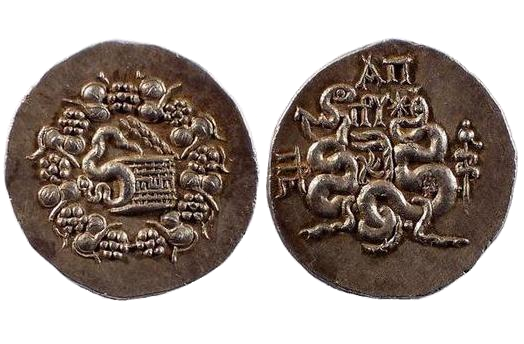
about ancient nomos
Ancient Nomos Art is a museum of galleries exhibiting ancient coins and ancient mint maps. The coin gallery displays the diverse art and history of hand-crafted ancient Greek, Roman, Byzantine, Persian and Medieval coinage. The ancient mints mapping gallery features Greek, Roman, Byzantine, Asia Minor and Medieval mint city regions and territories. Visitor's are welcome to explore, study and enjoy Ancient Nomos Art.

Greek, Mysia – 133 BC
Pergamon
From Ancient Galleries

Obverse: Serpent emerging from opening Cista Mystica in ivy wreath with fruit.
Reverse: Two coiled serpents with heads erect around bow and case. Serpent entwined Thrysus staff to right. Legend and star above, monogram in field to left.
LEGEND SYMBOLS
Obv. Serpent emerging from partially opened Cista Mystica; surrounded by ivy wreath with fruit. Rev. ΠΕΡΓ on left of two large and two small snakes around bow-case; serpent entwined Thyrsus in field to right; ΑΠ above with monograms and star.
The ancient city of Pergamon was situated on a hill to the north of the Caicus River, overlooking valleys in a region called Mysia. The city was a well planned development with beautiful Greek sculpture and art adorning the streets, buildings and temples. After the 3rd century Macedonian decline, the ruling Attalids dynasty helped foster a cultured reputation for Pergamon, renowned for its institutions of learning, medicine, art and the largest library outside Alexandria. Pergamon first issued this coin under Eumenes II, who likely required a new currency after the treaty with Apameia in 188 BC expanded his economic and political territory. The new coinage is the first time a king’s portrait and name are omitted from Hellenistic currency. The new currency was called a Cistophorus, named after the Cista of Dionysus. The coins obverse depicts a Cista Mystica, a small basket often seen being carried by Dionysus. The Cista was used during the worship of Dionysus and is considered sacred to the city, becoming the approved mythic emblem for the new city coinage. The cistophorus above depicts an open Cista with a mythic snake seen exiting its basket. The Cista is decorated with a center meander pattern and beads along the top and bottom. An ivy wreath, with alternating images of fruit, surrounds the Cista and snake. The coins reverse shows two large snakes and two smaller snakes intricately entwined around a bow-case. To the right of the snakes is the sacred Thyrsus of Dionysus. The Greek Thyrsus is a long symbolic pole featuring an entwined snake, topped with an arrangement of vines, ivy, and berries in a cone-like shape. The Thyrsus later developed into the staff carried by Asklepios and was known as a symbol of medicinal healing during the Roman Empire. The city monogram ΠΕΡΓ appears to the left of the snakes and the abbreviated magistrate’s initials, ΑΠΓΡΥ, followed by a star, is found above. Taken together, the obverse and reverse scenes appear to capture allegorical acts one and two of the Dionysian Cista fertility mythology in progress.
DOCUMENTATION
Value: Tetradrachm, in the Cistophoric weight standard. Metal: AR Silver. Weight: 12.52 grams. Mint: Pergamon, Mysia. Date: circa 76 BC.
Attribution: SNG von Aulock 1369. Kleiner, 25; ANS MN 23, 1978, page 80, 25; Pinder 122; Leu 59, 127.
Legend, Documentation and Attribution
